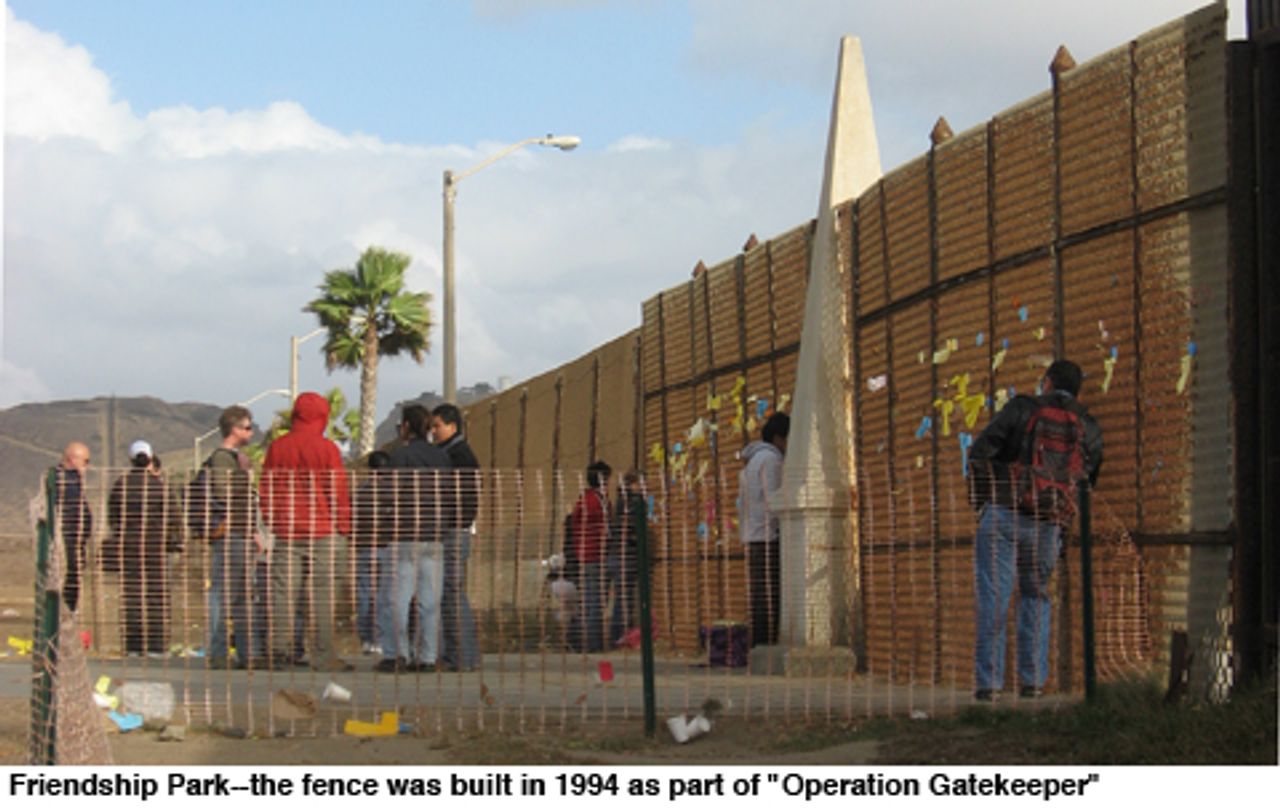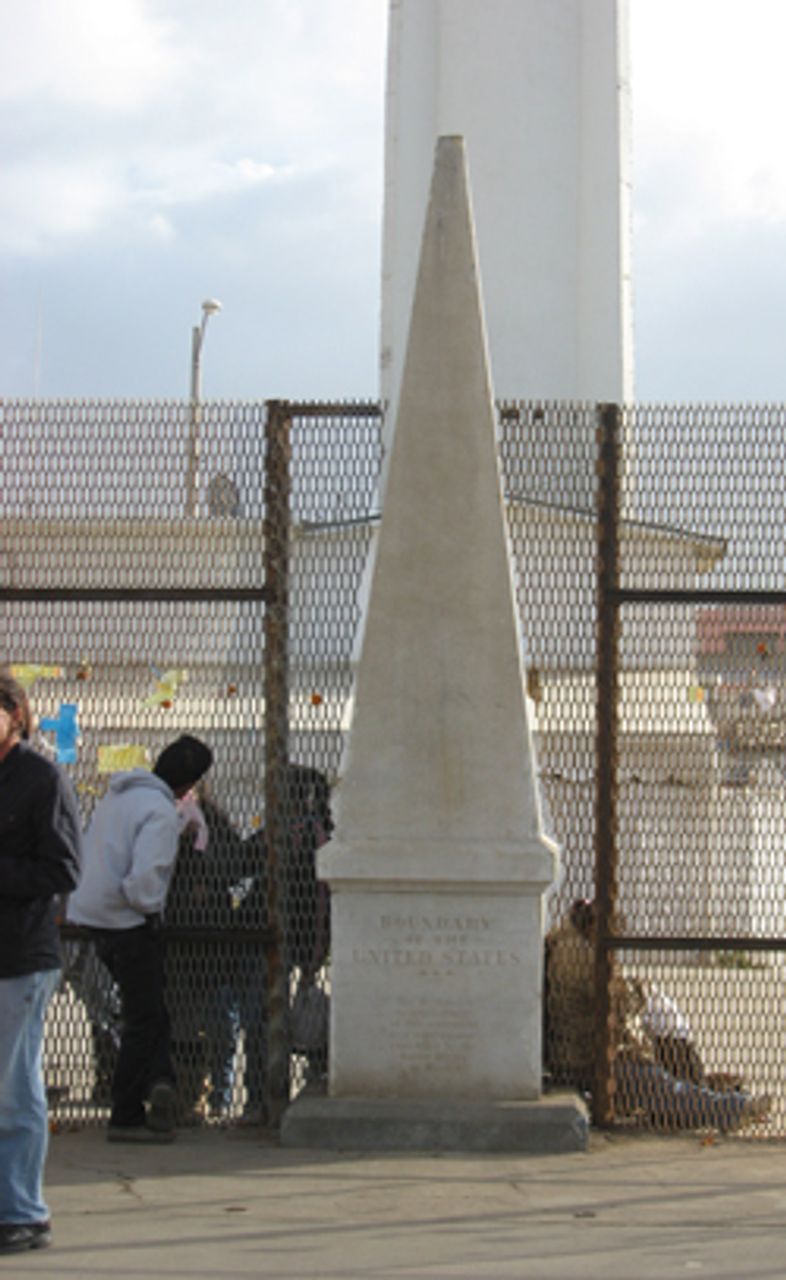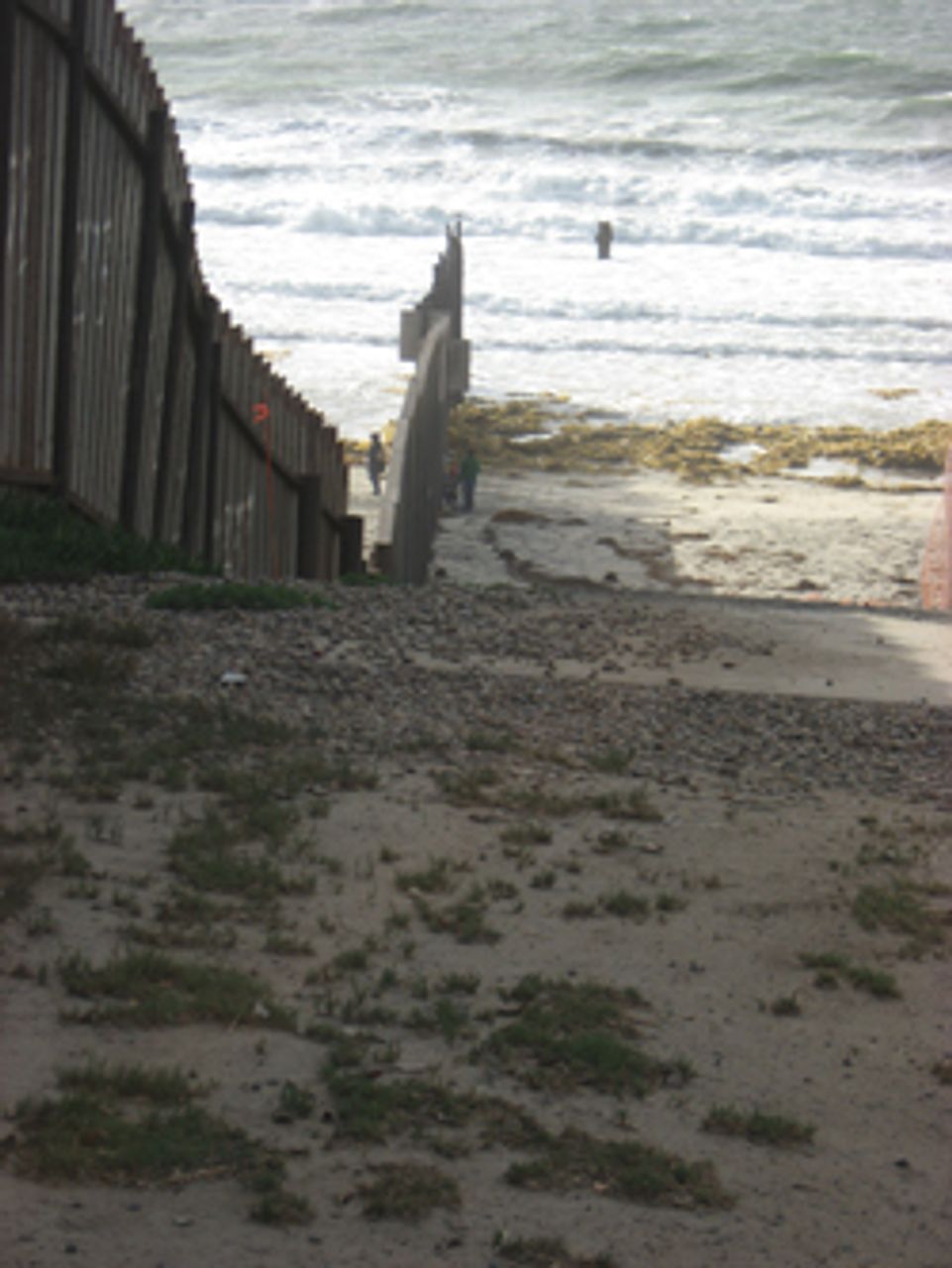 Friendship Park, named for a monument erected to symbolize the restoration of peaceful relations between the US and Mexico following the War of 1848, stands at the point where the border meets the Pacific Ocean. Over the years, residents on opposite sides of the border have come to rely on Friendship Park to serve as a meeting location. Near the monument, the border is demarcated by a relatively unobtrusive iron mesh fence, providing park visitors the ability to easily see and hear (and even, to a limited extent, to touch) people on the other side.
Friendship Park, named for a monument erected to symbolize the restoration of peaceful relations between the US and Mexico following the War of 1848, stands at the point where the border meets the Pacific Ocean. Over the years, residents on opposite sides of the border have come to rely on Friendship Park to serve as a meeting location. Near the monument, the border is demarcated by a relatively unobtrusive iron mesh fence, providing park visitors the ability to easily see and hear (and even, to a limited extent, to touch) people on the other side.
The fence was put into place in 1994 under the Clinton administration as part of a broader initiative dubbed “Operation Gatekeeper,” which included the erection of physical barriers and the establishment of immigration courts along the San Diego border.
The US Federal Government plans to replace the current wall with a more heavy-duty, three-tiered version, effectively abolishing the social function the park currently provides for friends and family torn apart by the arbitrary border. This project will cost an estimated $58 million. In the midst of the most severe economic crisis since the Great Depression, the government shows every intention of moving forward with this costly project, justified in the name of US national security and the “war on terror.”

Since its inception, Friendship Park has been fraught with contradictions. Two governments collaborated to erect a monument paying tribute to the “friendship” between them in the aftermath of a bloody and bitter conflict. While the monument celebrated friendship among two people, it also implicitly marked their separation.
The contradictory nature of the park is no less apparent today.
On the one hand, it provides a rare opportunity for transnational families to spend time together in a relatively relaxed environment. The loss of this space will no doubt negatively affect the lives of many working class citizens of the US and Mexico alike.
On the other hand, there is something degrading and repressive about the manner in which those fleeting moments of human contact take place – across a fence, with guards monitoring the situation, and within definite time constraints. The general atmosphere is not entirely unlike that of a prison.
Worker families, clergymen and politicians
The WSWS interviewed workers on both sides of the fence in Friendship Park. The atmosphere was an odd mixture of happiness and despair.
A man attempted to kiss his wife through the small three-inch wide gaps in the fence. He is a migrant working in the United States, trying to make money for his family. His youngest child was afraid to approach him. He had not seen his father in such a long time that he did not recognize him.
Another worker on the Mexican side had been deported three months before we met him. His children were still in the United States with his sister. He worked construction in the La Jolla area. He was deported when caught trying to cross back from Mexico. When asked if he would attempt to slip across again, he said, “No, I had a judge threatening to put me in jail for three years if I got caught trying to cross again.” He was at the park to meet a man that would give him advice on entering the US legally.
A woman was there to see several sisters, nephews, and nieces. She mentioned a time when she and her friends would cross the border by simply walking over a small one-foot tall barrier. She joked about wishing she had known that a fence would be put between the two countries, “I would have stayed in the States had I known we wouldn’t be allowed to come back.”
Her sister on the Mexican side spoke of the difficulties of crossing legally into the United States: “In order to get a visa, you have to prove that you’re financially stable here in Mexico. Showing that is really hard to do. You have to prove that you don’t have a need to go work in the United States. I’m not married, and that alone disqualified me from getting a traveling visa.”
A Christian pastor named John Fanestil arrived on the American side in order to perform a small religious ceremony. He is there every Sunday at 3pm to meet with workers on both sides of the border. Some Mexican workers come to the park from the other side to receive the Communion bread through the fence.
Gabriel Becerra, a migrant who crosses the border every day to work in the US, and who happened to stand on the other side when we talked to him, said “People just go there to see their family, in December they have festivals across both sides of the fence. I’m not sure why they want to take it down, it’s not hurting anyone. Besides the place is filled with agents, it’s not like people are crossing over.”
The scene was confounding. Workers came to the park to re-unite with friends and family, an understandably happy moment. Yet looming between them is a rusty fence that makes a simple hug impossible.

On the American side of Friendship Park is a black coffin, placed there to remind workers of the injustice of the fence. On the coffin are written several statements, “5,000 migrants dead 1994-2008, How many more?” The presence of a coffin labeled “Dreams of Liberty” reminds one that workers have a greater desire than to simply meet across a fence. To attain liberty, rather than send it to its grave, would require the removal of the fence and the abolition of all borders.
On another occasion, the WSWS was at Friendship Park during a press conference. Local Democratic congressman Bob Filner (California’s 51 Congressional District Representative) gave a very instructive speech that captures the fundamental hypocrisy of the political elite in general, and of the Democratic Party in particular.
“Bring this wall down,” was a quote repeated by most speakers at the press conference, Mr. Filner included. He pointed to a man and wife there meeting from opposite sides of the fence. He ridiculed the current administration for claiming to defend “family values” and yet keeping this fence in place. He called the proposed triple fence “a waste of money.” His speech was very much geared towards the workers on both sides of the border. Filner stated, “We have a fence instead of a bridge.”
This of course, is just rhetoric, and Filner has no intention of actually tearing down any walls.
On the floor of Congress Mr. Filner displayed a different attitude than the one he feigned at the park. According to the record, which Filner himself usefully highlights in his website (http://www.house.gov/filner/), on March 9th 2006 he stated: “Just a few weeks ago, we discovered almost a mile-long tunnel, half on each side of the border, in my district…Who knows what went through that tunnel, whether it was people, drugs or potentially weapons of mass destruction?”
Filner continued, “We know that with all of the fences that we are building, double fences, triple fences, walls, what we have here is an easy way under all of those fences that we are building…There is not even a law against tunneling under the border!...We have to understand that terrorism can find a whole new approach to getting into the United States through these tunnels underneath our international border. They are a threat to us and America. They allow drugs and people to come through.”
Filner, in other words, accepts both the fraudulent framework of the “war on terror,” as well as the preposterous notion that the border is a crucial front in this “war.”
Although in front of workers and cameras in Friendship Park Filner waxed poetic about building bridges across borders to unite families, he is on record as pushing to “improve monitoring and prosecuting of businesses who knowingly hire illegal immigrants.”
On his web site, Filner boasts that he is “truly California’s Border Congressman,” a title that reveals more than he might have intended. His duplicity reveals the class basis of the Democratic Party he represents. He is simply mimicking the same type of cynicism and outright dishonesty permeating every level of the party, up to and including the president-elect, Barack Obama.
Obama and the border
Obama’s campaign messages of “hope” and “change you can believe in” clearly had an effect on those present at Friendship Park. The WSWS talked to a number of people who have been politically active in border politics for years. To a person, they all said that Washington has been a closed door throughout the Bush Administration, and that they hoped this would change with the incoming Obama Administration. At the same time, all the people we talked to admitted that Congress had been no more receptive or helpful on the issue since the Democrats won decisive control of both houses in 2006.
This is a false hope that will soon be dashed. As posted on his own official web site, Obama’s number one goal regarding immigration policy is “securing the borders.” To accomplish this, Obama “supports additional personnel, infrastructure and technology at our borders and our ports of entry.” Obama, in other words, supports building new walls such as the project planned for Friendship Park.
When Obama talks of “securing the border” by building up “infrastructure,” it can only be taken as an appeal to reactionary anti-immigrant sentiments at the expense of US and Mexican workers living and working on either side of the border.
Obama’s cabinet provides the strongest indication of what his administration has in store. He recently appointed Arizona Governor Janet Napolitano, a right-wing Democrat, to the office of Secretary of the Department of Homeland Security. In so doing, he has put at the head of immigration policy a person with an established history of anti-immigrant border politics.
Napolitano demanded the further militarization of the border by deploying National Guard troops in her state. The Bush administration initially resisted this initiative, and only followed her lead after months of hesitation, finally providing federal funds and extending its scope to the other border states. When this initiative, known as “Operation Jump Start,” was finally launched in 2006, Napolitano remarked, “I would call it ‘Operation It’s About Time.’”
Napolitano is, perhaps, most infamous for her role in the so-called Chandler Roundup, which took place in a Phoenix suburb in July 1997. This event featured the roundup and deportation of hundreds of workers, broad-scale harassment, and racial-profiling. At the time, Napolitano served as the US attorney having jurisdiction over the Border Patrol.
The reaction of the right-wing anti-immigrant camp to the Napolitano appointment is also telling. The Associated Press reported, “Mark Krikorian, director of the Center for Immigration studies, which advocates for strict immigration laws” expressed satisfaction with the pick. “She has cultivated a hawkish pose on illegal immigration, which is mostly for show but not without foundation.”
Conspicuous in the press coverage of the pick is the now familiar refrain about the importance of a “smooth transition” between the Bush and Obama administrations. John Yaukey of the Republican Washington Bureau, for example, writes how outgoing secretary Michael Chertoff “praised Napolitano…as a ‘terrific pick’” with whom he will be in contact to ensure a “smooth transition” (Republican Washington Bureau, 12/4/08).
In the final analysis, after the “smooth transition” from Chertoff to Napolitano, the latter will settle easily into a role with which she is quite familiar: an enforcer for the same ruling elite that dictated immigration policy throughout the Bush administration.
In the final analysis, Friendship Park and the surreal stretch of border in San Diego is a poignant manifestation of the irrationality of all borders, and of the nation-state system upon which capitalism rests. The Socialist Equality Party affirms the right of working people to live wherever they choose. The political prerequisite for realizing this right is a break with the Democratic Party and the independent political mobilization of the working class in the struggle for socialism.
